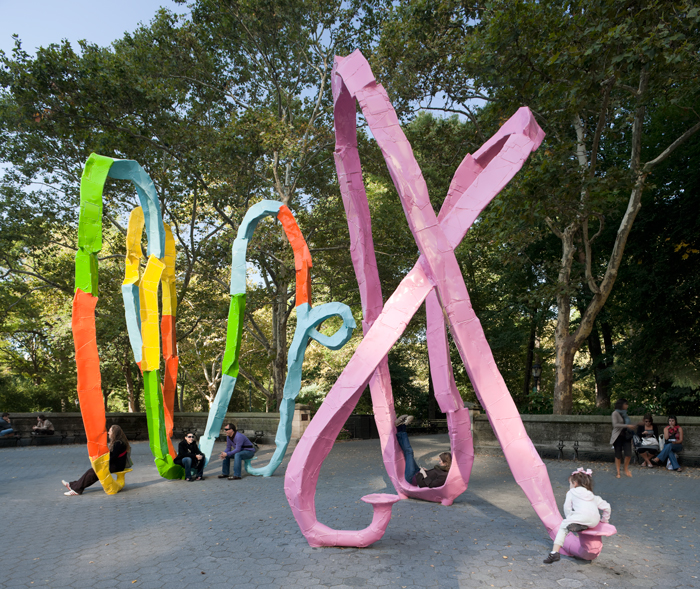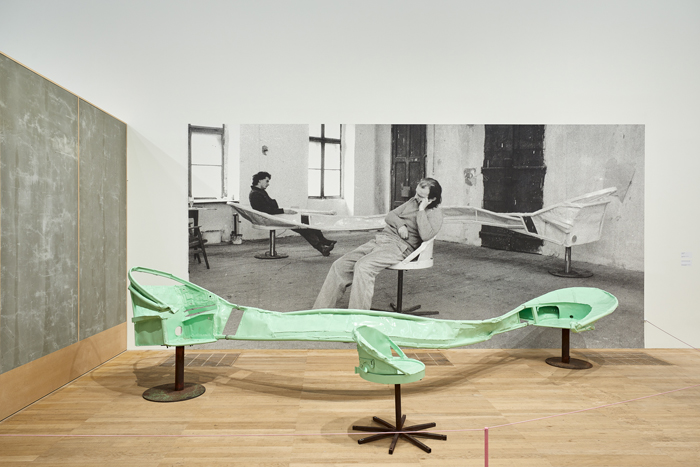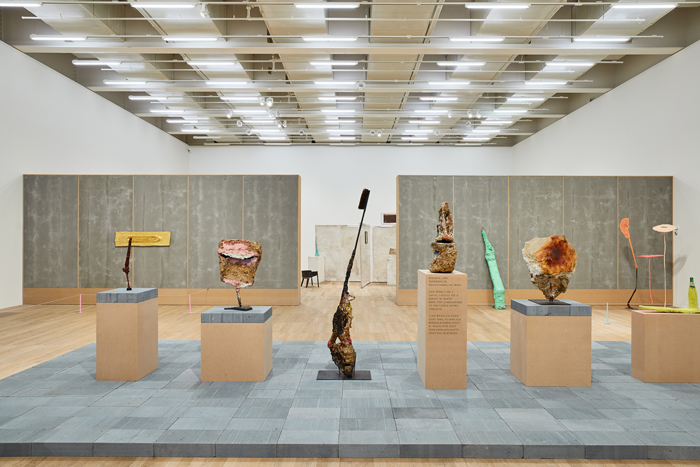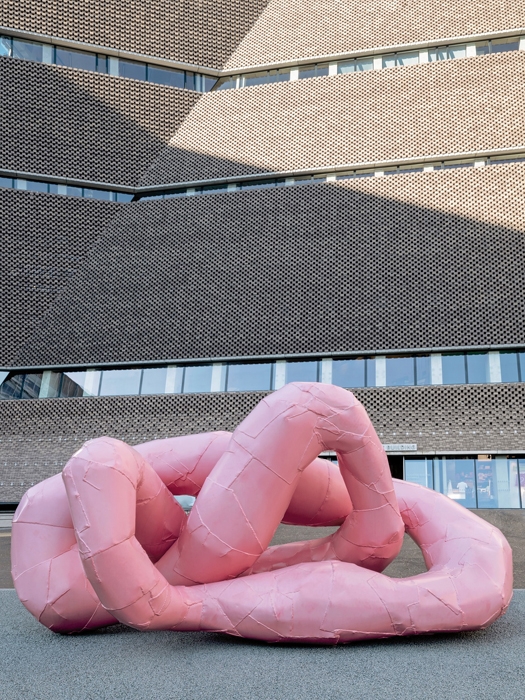A few months ago I spent an afternoon on the job with a friend who works as a dog walker. I grew up with pets and so consider myself unflappable when it comes to ‘picking up after them’, but that afternoon I experienced the ritual in a new light. By the time we had finished our walk my friend’s waistband was decorated with brightly coloured sacks that swung in time with the rhythm of his hips. Faced with the responsibility of looking after multiple dogs at once, often miles away from the nearest bin, he had devised a pragmatic but unusual solution: tying the poo bags onto the belt loops of his jeans. I found these fetid additions to his outfit oddly compelling, and instead of wrinkling my nose I smiled. I thought of Franz West.
West, who died in 2012, was an artist of many virtues. Few could rival his dignity-puncturing collages of meat, porn and unsuspecting figures cut from the pages of magazines – fewer still could give a lump of papier-mâché the air of a drunk attempting a pirouette at the end of a heavy night. Yet to my mind, his most remarkable quality was a capacity to see the joy and universality of shit, and to recognise its efficacy as the basis for public sculpture. Among my favourite of his outdoor works are the Sitzwurst (2000), giant, party-coloured aluminium turd-forms that have made appearances on lawns including at Schlosspark, Vienna, and Regent’s Park, London, revealing at a grotesque scale what is usually already lurking in the grass. West’s interests extended up the gut, and to objects that enter the anus as well as those that leave it. In 2009 The Ego and the Id was installed in Central Park, New York, two 6m-tall spiralling frames on which visitors are invited to sit as if perching on lengths of cartoon intestine. And then there is Dorit (2002), currently standing outside Tate Modern, London, a sculpture that looks like an erect string of anal beads painted a shade of piggy flesh West was fond of using.

Producing outdoor sculpture is doubtless one of the hardest tasks an artist can take on. The world beyond the gallery can be an unforgiving place: if your idea isn’t overwhelmed by the environment, or irreparably dulled by regulation, chances are the public will come for you. For the outside observer, the spectacle of art going toe-to-toe with the very people on whose behalf it is ostensibly made has offered ample opportunity for schadenfreude. Consider the thefts of Henry Moore sculptures, melted and sold for their value as scrap metal, or the fate of Richard Serra’s Tilted Arc (1981), an ominous wall of steel that divided Foley Federal Plaza in Manhattan throughout the 1980s, until a judge ordered its removal at the request of local workers disgruntled by the imposition upon their lunch spot. ‘Is the purpose of art in public places to seal off a route of escape, to stress the absence of joy and hope?’, a clerk from a nearby building enquired during the trial.
In part, West avoided having his pants pulled down by the public because his works suggested that they were already around his ankles. Near-literally, in the case of Etude de couleur [Colour Study], a pissoir with a lake view installed as part of Skulptur Projekte Münster in 1997. If this makes him sound boorish, in reality his work is an object lesson in geniality. Nobody could accuse West of sucking the joy from a park or square. Made from bent and welded sheet metal, his giant shits, guts and sex toys have the look of patched up DIY inflatables; a far cry from the statues of imperial eagles, emperors and military commanders typical to Vienna, where he grew up. The impression of lightness is enhanced by the fact that West never attempted to disguise the hollowness of his structures – a material honesty that remains unusual in public sculpture, which still tends to rely on looking solid and expensive in order to command attention. (Who’s boorish now?)
West avoided having his pants pulled down by the public because his works suggested that they were already around his ankles
West’s lexicon of dirt emerged from Allied-Occupied Vienna, and early encounters with the Austrian avant-garde scene during the 1960s. “It was more than dirty – filthy”, he said of the housing project he lived in as a child. During the Second World War, 20 percent of the capital’s housing was lost to bomb damage, but he was referring to more than architectural rubble. West was born in 1947, his mother of Jewish heritage; before the outbreak of war both his parents had been communists. Austria’s postwar implementation of ‘victim theory’ meant even the most ardent Hitler supporters were declared victims of Nazism, and free to resume work as politicians, doctors and teachers. Unsurprisingly, West was sanguine about his family’s neighbours. ‘Just about everyone had been a Nazi,’ he said. ‘Otherwise why didn’t they run away?’
When West was sixteen, he saw the first public event staged under the umbrella of Viennese Actionism, a body art movement whose performances involved, among other things, animal carcasses, body fluids, live sex and public whippings. Actionism intended to confront the violence lurking beneath the surface of bourgeois propriety with displays of wanton brutality. West shared Actionism’s interest in bodily material, but not their tactics. He was apparently depressed for weeks after watching Rudolf Schwarzkogler, an artist best known for wrapping himself in bandages and bleeding from self-inflicted wounds, mutilate a lamb. West was sceptical of what he considered the movement’s Catholic tendencies; when he used obscene materials, he did so to unite audiences rather than to scandalise them.
Shit holds a particular place in the Austrian imagination: Sigmund Freud considered the decision to let it go key to a child’s psychosexual development; Austrian toilets are designed to display rather than hide. For his part, West considered it a substance with significant democratic potential. (‘Everybody likes shit anyway,’ as he once put it.) By utilising the quotidian dirt and involuntary act of creativity we all have in common, he may have achieved something few have managed: finding a form, and a subject, capable of relating to as fractious and sundry an audience as the general public. In this regard, his work is an example of what Russian philosopher Mikhail Bakhtin called ‘grotesque realism’ in his 1965 study Rabelais and His World: a genre of art that focuses on the places through which ‘the world enters the body or emerges from it, or through which the body itself goes out to meet the world’. Bakhtin considered grotesque realism an expression of solidarity, a celebration of life in all its indecorous glory, ideas echoed in West’s bunting-hued, shitpositive public statuary.


West was a serial collaborator who worked with artists – including Mike Kelley and Michelangelo Pistoletto – and also enlisted viewers. One of the most striking things about his work is what good company it makes. It shares a joke. It may even offer you a seat. And like the kind of friend whose mannerisms you adopt after hanging out with, its demeanour is catching. The Adaptives – sculptures West began producing during the 1970s from papier-mâché, plaster and gauze that participants are invited to handle – are an early example of the conviviality he later gave to public sculpture. In a photograph taken in 1974, the artist Otto Kobalek stands in front of a scruffy concrete wall posing for the camera. He appears to be naked except for a pair of loafers, a watch and an Adaptive that he is wearing around his waist like an oversized wonky tutu. Gently cocking his head, pointing his toe and spreading his fingers over the brim of the object, Kobalek looks profoundly silly yet also debonair: he has become one with the disposition of the Adaptive.
During the late 1990s, the art historian Bice Curiger asked West to describe his approach to making public art. The answer he gave sums up the philosophy that made him so well suited to the task. ‘[Max] Horkheimer said that he would prefer it if life were more intense and art less interesting – not that there were no art, just that art were less meaningful, and that’s what I like about public art,’ he replied. ‘Art that people have hanging around, that stands about in spaces with other people – that’s the kind of art I want to do.’ For West art was a perspective to be shared, a way to facilitate togetherness, something you’d like to hang around with. He knew that we are all in the gutter, and he set about making it a funnier, friendlier, more communal place to be.
A retrospective of Franz West’s work is on view at Tate Modern, London, through 2 June
Rosanna Mclaughlin is a writer and editor based in London
From the Summer 2019 issue of ArtReview
